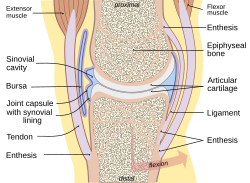
Back ارتكاز Arabic Èntesi Catalan آنتز Persian Enthèse French Entesi Italian Enthesis Latin 着骨点 Chinese
| Enthesis | |
|---|---|
 Typical joint | |
| Identifiers | |
| TH | H3.03.00.0.00034 |
| Anatomical terminology | |
The enthesis (plural entheses) is the connective tissue between tendon or ligament and bone.[1]
There are two types of entheses: Fibrous entheses and fibrocartilaginous entheses.[2][3]
In a fibrous enthesis, the collagenous tendon or ligament directly attaches to the bone.
In a fibrocartilaginous enthesis, the interface presents a gradient that crosses four transition zones:[4]
- Tendinous area displaying longitudinally oriented fibroblasts and a parallel arrangement of collagen fibres
- Fibrocartilaginous region of variable thickness where the structure of the cells changes to chondrocytes
- Abrupt transition from cartilaginous to calcified fibrocartilage—often called 'tidemark' or 'blue line'
- Bone
- ^ "enthesis". Medcyclopaedia. GE. Archived from the original on 2012-02-05.
- ^ Thomopoulos S, Birman V, Genin G, eds. (2012). Structural Interfaces and Attachments in Biology. New York: Springer. ISBN 9781461433163.
- ^ Rothrauff BB, Tuan RS (January 2014). "Cellular therapy in bone-tendon interface regeneration". Organogenesis. 10 (1): 13–28. doi:10.4161/org.27404. PMC 4049890. PMID 24326955.
- ^ Genin GM, Thomopoulos S (May 2017). "The tendon-to-bone attachment: Unification through disarray". Nature Materials. 16 (6): 607–608. Bibcode:2017NatMa..16..607G. doi:10.1038/nmat4906. PMC 5575797. PMID 28541313.